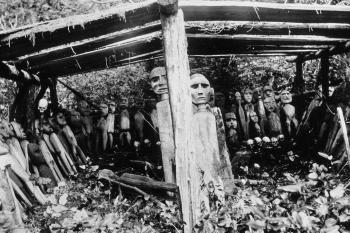Image Caption
Local Journalism Initiative Reporter
Windspeaker.com
Members of the Mowachaht/Muchalaht First Nations Whalers’ Shrine Repatriation Committee travelled to New York recently in an effort to try to bring back one of the world’s most sacred structures.
Committee members went to the American Museum of Natural History (AMNH) to formally meet with the museum’s Cultural Resources Office.
The representatives from the First Nations in British Columbia are keen to bring the Whalers’ Shrine back home to Yuquot, a village in Nootka Island, on the northwest coast of Vancouver Island.
The shrine was where Nuu-chah-nulth whalers prayed and practiced ritual oosemich (bathing) to prepare for the physical and spiritual challenges they faced when hunting.
There are 88 carved human figures, four carved whale figures and 16 human skulls in the shrine.
Led by hereditary Chief Mike Maquinna, Chief Jerry Jack, and Elder Margaretta James, committee members discussed the next steps to complete the process required for repatriation.
The meeting included a private viewing and ceremonial blessing of the full inventory of the Whalers’ Shrine collection.
James said that 16 ancestors need to be honoured.
“It was removed, acquired, stolen, whichever verb you want to use in 1904,” James said. “The museums at the time were acquiring Indian artifacts because they believed that the Indians to be disappearing.”
It was removed by George Hunt and Franz Boas in 1904 while the community was away for seasonal hunting – and has never been fully displayed at the museum.
The journey to reclaim the shrine has been long and difficult.
The place the shrine stood in the forest for more than 4,000 years was recognized in 1923 as a National Historic Site by Parks Canada, as “a unique ceremonial structure and the most significant monument to a purification ritual on the West Coast.”
However, the initial plaque failed to even acknowledge the Indigenous history. Eventually, the community succeeded in changing the narrative to reflect their rich heritage.
“Our nation has been applying for UNESCO World Heritage Site designation for Yuquot and the Shrine, and we were turned down in 2015 to be placed on Canada's tentative list,” James said.
“When we were turned down, our chief (Tyee Ha'wiih Mike Maquinna) said, ‘We're not giving up the policies and the applications are so bureaucratic, and how can you speak to the spirit of a nation? How can you speak to the spirit of the shrine?’”
James explained the Maquinna family held that responsibility.
“And they practiced the rituals with that shrine – for millennia,” she said. “This is for many, many, many, many years. And you only have to have been in the presence of the shrine to feel that power of the culture.
“It was secretive, I'll say almost a secret society around the shrine.”
In 1988 museum representatives came to the community to ask for more information. They wanted to replicate the shrine as a display. James said some Elders had details.
“We actually never gave them an answer,” James said. “But we started the whole process for its return, now throughout decades. And it's just amazing how powerful that culture is now, in that we're getting it back. It's going back to its home.”
In the 1960s, Parks Canada conducted an excavation at Yuqout, unearthing human remains and confirming continuous human habitation for more than 4,300 years. Those ancestors were respectfully returned to their resting place, a process guided by the Elders.
In the United States, the Native American Graves Protection and Repatriation Act requires cultural items to be returned to 'lineal descendants'.
An AMNH spokesperson said there approximately 2,200 Native American ancestral remains at the museum.
James described the shrine as a powerful symbol of Indigenous culture with a deep spiritual significance.
Two years ago, James was able to bring two of her grandchildren to see the shrine.
“Just to keep the connection with the museum and to say, ‘We're still here, still working on it,’” she said. “But they never displayed the skulls to us, but all the carved pieces.”
James said it was life changing when she first saw part of the shrine.
“You really feel oneness in those moments when you're there, how powerful that is – and what it is,” she said. “The power of the spirit, you can't hardly put words to it.”
The return of the shrine is not just a matter of cultural heritage but also a healing moment in the community experiencing the multi-generational impacts of colonialism.
"Living here, being with the people, you feel how powerful Yuquot is, and the shrine,” James said.
Members of the community have been preparing for a repatriation, ensuring that their traditions and rituals are honored.
“We're really grateful and appreciative that it's coming together now with the support of the chiefs and the community,” James said. “This is a journey of great hope and renewal to honor our ancestral cultural heritage and the spirit of the Mowachaht/ Muchalaht people.”
As James was preparing for the journey to New York, she said she was carrying with her the hopes and dreams of her people.
It is a step towards reclaiming their history, honoring their ancestors, and healing the wounds of the past.
“Most of the Elders that spoke for the shrine in the 80’s and 90’s, they're gone,” James said. “They passed. But we're here– and we're ready."

